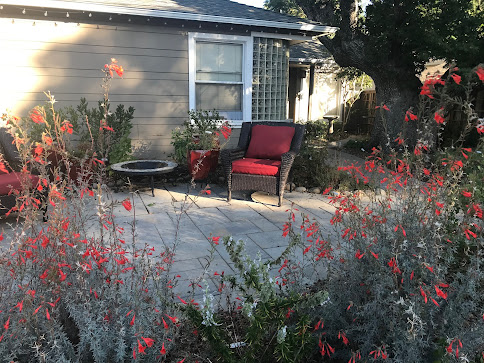Summer Joy! California Fuchsias and Bees
The California "Moonglow" poppies have ceded the stage and the California Fuchsias are having their moment. Known also as Epilobium canum, these have the common name of 'fuchsia' as the flower form is reminiscent of the imported plant by that name.
These plants are powerhouses in the garden, blooming from late July into October, and feeding White Lined Sphinx moth caterpillars (in my sister-in-law's garden) and a variety of bees. I had originally planted just one of these plants to try it out, and as soon as it bloomed, a hummingbird appeared. After drinking from its meager 12 blossoms, the hummingbird zoomed over to me, hovered in front of my face as if to say "plant more!" I wound up adding 5 more and am so glad that I did. The hummingbirds visit this frequently and it is a favorite with the bees.
Even late in the day the blossoms seem to glow and draw a lot of comments from neighbors and other passer-by. A troop of Girl Scouts toured the garden one afternoon, and some stayed behind to collect seeds. Luckily I had some extra empty packets handy.
The seeds pop open and are held in place briefly by their 'fluff'. I learned quickly that the trick to harvesting is to keep your hand around the pod, and nip it off the stem with your thumbnail. Trying to tear the pod off the stem severs it as they snap easily and this wastes the unripened pods further up the stem.
The European honeybees crawl all the way in the flower and completely disappear. There were typically 15-20 buzzing around at any given moment. As I was harvesting seeds, they'd sense my presence and fly over to another area on the plant. We worked quite closely together but were careful to respect each other's space. It was actually quite relaxing to hear all of their humming and buzzing.
It was such a challenge to photograph this tiny sweat bee as it was so small and very quick. It was nice to see some bee diversity in the garden, though. It seems that with each new California native plant that I introduce into the garden, a new crop of bees and other insects show up. That is very exciting and I can't wait to see what the next phase will bring!
Hummingbird with Epilobium canum (c) Ann Parsons (CC-BY-NC)









Comments
Post a Comment
Please Leave a Reply